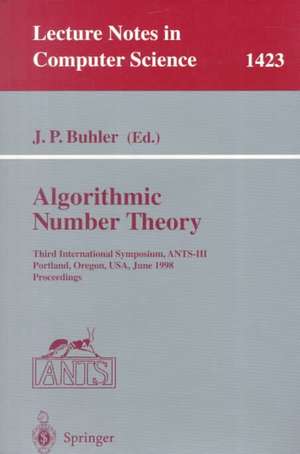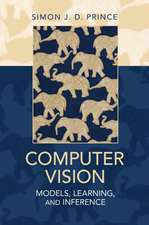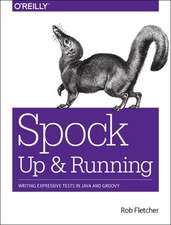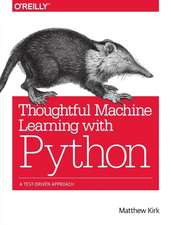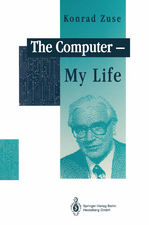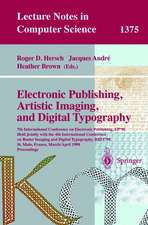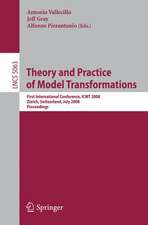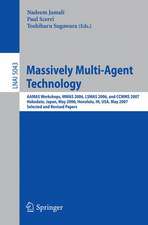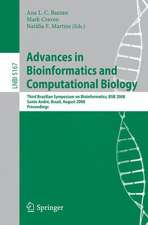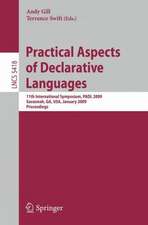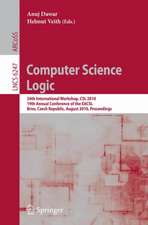Algorithmic Number Theory: Third International Symposium, ANTS-III, Portland, Orgeon, USA, June 21-25, 1998, Proceedings: Lecture Notes in Computer Science, cartea 1423
Editat de Joe P. Buhleren Limba Engleză Paperback – 5 iun 1998
The volume presents 46 revised full papers together with two invited surveys. The papers are organized in chapters on gcd algorithms, primality, factoring, sieving, analytic number theory, cryptography, linear algebra and lattices, series and sums, algebraic number fields, class groups and fields, curves, and function fields.
Din seria Lecture Notes in Computer Science
- 20%
 Preț: 1061.55 lei
Preț: 1061.55 lei - 20%
 Preț: 307.71 lei
Preț: 307.71 lei - 20%
 Preț: 438.69 lei
Preț: 438.69 lei - 20%
 Preț: 645.28 lei
Preț: 645.28 lei -
 Preț: 410.88 lei
Preț: 410.88 lei - 15%
 Preț: 580.46 lei
Preț: 580.46 lei - 17%
 Preț: 427.22 lei
Preț: 427.22 lei - 20%
 Preț: 596.46 lei
Preț: 596.46 lei -
 Preț: 381.21 lei
Preț: 381.21 lei - 20%
 Preț: 353.50 lei
Preț: 353.50 lei - 20%
 Preț: 1414.79 lei
Preț: 1414.79 lei - 20%
 Preț: 309.90 lei
Preț: 309.90 lei - 20%
 Preț: 583.40 lei
Preț: 583.40 lei - 20%
 Preț: 1075.26 lei
Preț: 1075.26 lei - 20%
 Preț: 310.26 lei
Preț: 310.26 lei - 20%
 Preț: 655.02 lei
Preț: 655.02 lei - 20%
 Preț: 580.93 lei
Preț: 580.93 lei - 20%
 Preț: 340.32 lei
Preț: 340.32 lei - 15%
 Preț: 438.59 lei
Preț: 438.59 lei - 20%
 Preț: 591.51 lei
Preț: 591.51 lei - 20%
 Preț: 649.49 lei
Preț: 649.49 lei - 20%
 Preț: 337.00 lei
Preț: 337.00 lei -
 Preț: 449.57 lei
Preț: 449.57 lei - 20%
 Preț: 607.39 lei
Preț: 607.39 lei - 20%
 Preț: 1024.44 lei
Preț: 1024.44 lei - 20%
 Preț: 579.30 lei
Preț: 579.30 lei - 20%
 Preț: 763.23 lei
Preț: 763.23 lei - 20%
 Preț: 453.32 lei
Preț: 453.32 lei - 20%
 Preț: 575.48 lei
Preț: 575.48 lei - 20%
 Preț: 585.88 lei
Preț: 585.88 lei - 20%
 Preț: 825.93 lei
Preț: 825.93 lei - 20%
 Preț: 763.23 lei
Preț: 763.23 lei - 17%
 Preț: 360.19 lei
Preț: 360.19 lei - 20%
 Preț: 1183.14 lei
Preț: 1183.14 lei - 20%
 Preț: 340.32 lei
Preț: 340.32 lei - 20%
 Preț: 504.57 lei
Preț: 504.57 lei - 20%
 Preț: 369.12 lei
Preț: 369.12 lei - 20%
 Preț: 583.40 lei
Preț: 583.40 lei - 20%
 Preț: 343.62 lei
Preț: 343.62 lei - 20%
 Preț: 350.21 lei
Preț: 350.21 lei - 20%
 Preț: 764.89 lei
Preț: 764.89 lei - 20%
 Preț: 583.40 lei
Preț: 583.40 lei -
 Preț: 389.48 lei
Preț: 389.48 lei - 20%
 Preț: 341.95 lei
Preț: 341.95 lei - 20%
 Preț: 238.01 lei
Preț: 238.01 lei - 20%
 Preț: 538.29 lei
Preț: 538.29 lei
Preț: 663.13 lei
Preț vechi: 828.91 lei
-20% Nou
Puncte Express: 995
Preț estimativ în valută:
126.92€ • 131.99$ • 106.20£
126.92€ • 131.99$ • 106.20£
Carte tipărită la comandă
Livrare economică 15-29 martie
Preluare comenzi: 021 569.72.76
Specificații
ISBN-13: 9783540646570
ISBN-10: 3540646574
Pagini: 656
Ilustrații: X, 646 p.
Dimensiuni: 155 x 235 x 34 mm
Greutate: 0.9 kg
Ediția:1998
Editura: Springer Berlin, Heidelberg
Colecția Springer
Seria Lecture Notes in Computer Science
Locul publicării:Berlin, Heidelberg, Germany
ISBN-10: 3540646574
Pagini: 656
Ilustrații: X, 646 p.
Dimensiuni: 155 x 235 x 34 mm
Greutate: 0.9 kg
Ediția:1998
Editura: Springer Berlin, Heidelberg
Colecția Springer
Seria Lecture Notes in Computer Science
Locul publicării:Berlin, Heidelberg, Germany
Public țintă
ResearchCuprins
Shimura curve computations.- The Decision Diffie-Hellman problem.- Parallel implementation of Schönhage's integer GCD algorithm.- The complete analysis of the binary Euclidean algorithm.- Cyclotomy primality proving — Recent developments.- Primality proving using elliptic curves: An update.- Bounding smooth integers (extended abstract).- Factorization of the numbers of the form m 3 + c 2 m 2 + c 1 m + c 0.- Modelling the yield of number field sieve polynomials.- A Montgomery-like square root for the Number Field Sieve.- Robert Bennion's “hopping sieve”.- Trading time for space in prime number sieves.- Do sums of 4 biquadrates have a positive density?.- New experimental results concerning the Goldbach conjecture.- Dense admissible sets.- An analytic approach to smooth polynomials over finite fields.- Generating a product of three primes with an unknown factorization.- On the performance of signature schemes based on elliptic curves.- NTRU: A ring-based public key cryptosystem.- Finding length-3 positive Cunningham chains and their cryptographic significance.- Reducing ideal arithmetic to linear algebra problems.- Evaluation of linear relations between vectors of a lattice in euclidean space.- An efficient parallel block-reduction algorithm.- Fast multiprecision evaluation of series of rational numbers.- A problem concerning a character sum.- Formal power series and their continued fraction expansion.- Imprimitive octic fields with small discriminants.- A table of totally complex number fields of small discriminants.- Generating arithmetically equivalent number fields with elliptic curves.- Computing the lead term of an abelian L-function.- Timing analysis of targeted hunter searches.- On successive minima of rings of algebraic integers.- Computation of relativequadratic class groups.- Generating class fields using Shimura reciprocity.- Irregularity of prime numbers over real quadratic fields.- Experimental results on class groups of real quadratic fields.- Computation of relative class numbers of imaginary cyclic fields of 2-power degrees.- Formal groups, elliptic curves, and some theorems of Couveignes.- A comparison of direct and indirect methods for computing Selmer groups of an elliptic curve.- An algorithm for approximate counting of points on algebraic sets over finite fields.- S-integral points on elliptic curves and Fermat's triple equations.- Speeding up Pollard's rho method for computing discrete logarithms.- A general method of constructing global function fields with many rational places.- Lattice basis reduction in function fields.- Comparing real and imaginary arithmetics for divisor class groups of hyperelliptic curves.- Unit computation in purely cubic function fields of unit rank 1.- An improved method of computing the regulator of a real quadratic function field.- The equivalence between elliptic curve and quadratic function field discrete logarithms in characteristic 2.
